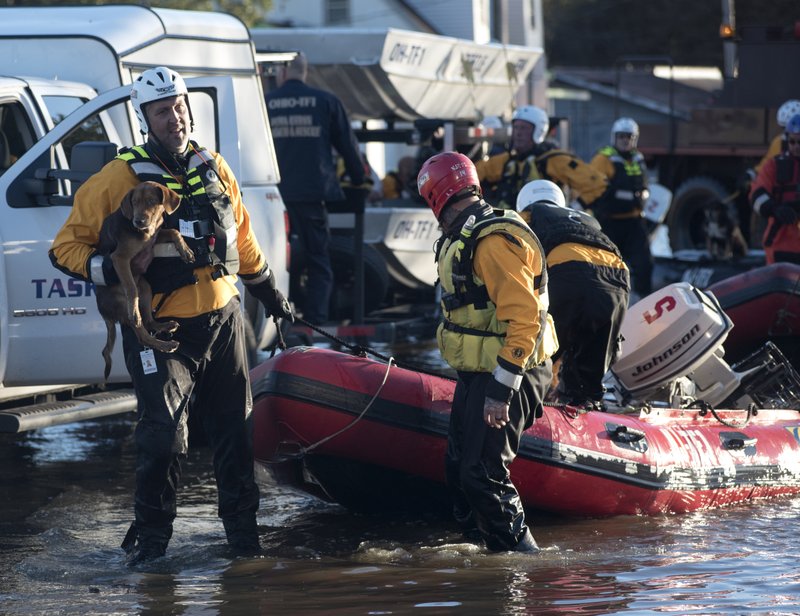GREENVILLE, N.C. -- Thousands more people were ordered to evacuate as high water from Hurricane Matthew pushed downstream Tuesday, two days after the storm blew out to sea.
"Move to higher ground now," said a report issued by the National Weather Service.
Matthew's death toll in the U.S. climbed to 30, half of them in North Carolina, in addition to the hundreds of dead in Haiti.
In Greenville, a city of 90,000, officials warned that the Tar River would overwhelm every bridge in the county by sundown, splitting it in half before the river crests late Wednesday. Evacuations were ordered there and in such communities as Goldsboro and Kinston, as rivers swelled to some of the highest levels ever recorded.
Tens of thousands of people, some of them as much as 125 miles inland, have been warned to move to higher ground since the hurricane drenched the state with more than a foot of rain over the weekend during a run up the East Coast from Florida.
An angry Gov. Pat McCrory asked people to stop ignoring evacuation orders and driving around barricades on flooded roads.
"That is unacceptable," McCrory said. "You are not only putting your life in danger; you are putting emergency responders' lives in jeopardy."
In Robeson County, an impoverished inland area, rescue workers were scrambling to reach more than 1,000 people, many of them in a neighborhood of small apartment complexes and public housing.
By the afternoon, rescue units had reached many, depositing them at a staging area where they held dripping suitcases, plastic bags of clothing and portable breathing machines.
"But this could still get a lot worse," said John Locklear, a local volunteer firefighter who was driving one of the military vehicles. "Each house is going have to be searched. Just like New Orleans."
In the hard-hit town of Lumberton, the Lumber River was a record 24 feet above its usual level. "I'm scared to give you an estimate" about the death toll, said Erich Hackney, a councilman for the city of Lumberton, "and I'm scared to know what we'll find."
Sporadic looting was reported in the city, and a North Carolina trooper searching for people trapped by the floodwaters killed a man who confronted officers with a gun Monday night, police said.
Authorities gave few details, but McCrory said the shooting happened in "very difficult circumstances," adding, "Tension can be high when people are going through very, very emotional circumstances."
In Lumberton, patience was wearing thin.
Ada Page, 74, spent two nights sleeping in a hard plastic folding chair at a shelter put together so hastily there were no cots and people had to walk outside in the back to use portable toilets. She complained she didn't even have her children's telephone numbers with her.
"I left at home all my clothes, everything. The only thing I have is this child and what I was driving," said Page, who was with the 8-year-old granddaughter she takes care of.
Matthew tracked closer to the North Carolina coast than predicted, and Lara Pagano, a Weather Service hydrologist, said the forecast only changed "truly as [the event] was happening."
"Hurricanes will wobble back and forth and that makes all the difference in where we see the heaviest rainfall," she said.
The full extent of the disaster in North Carolina was still unclear, but it appeared that thousands of homes were damaged. Many likened Matthew to Hurricane Floyd, which did $3 billion in damage and destroyed 7,000 homes in North Carolina as it skirted the state's coast in 1999.
McCrory said thousands of animals drowned, mostly chickens on poultry farms, and he was deciding how to dispose of the carcasses safely.
The flooding extended to South Carolina, where 150 people had to be rescued Monday from the tiny town of Nichols, downstream from Lumberton. On Tuesday, some residents returned in boats to survey the damage.
Also flooding were the Neuse River, which reached a record crest in Goldsboro on Tuesday, and the Tar River, which threatened Princeville, a town founded in 1865 by freed slaves and destroyed by Floyd's flooding 17 years ago.
After that, the river flows into Greenville, where Danita Lynch wasn't taking any chances. She helped her 59-year-old mother load nearly all her belongings into a box truck and get to higher ground.
"We decided to pack her up yesterday. The water is right across the street," Lynch said.
East Carolina University in Greenville canceled classes for the rest of the week for its more than 28,000 students.
Mary Schulken, the school's executive director of communications, said that as the Tar began flooding over the weekend, she had to move her 98-year-old mother and her belongings out of her retirement community next to the river.
"She was fearful, upset, anxious, and when she's that way, I'm that way," Schulken said. "I know that is a personal experience that is being repeated and has the potential to be repeated many times over in this community."
Not everyone was obeying the evacuation order.
Angie Hamill was still serving drinks Tuesday afternoon at the Players Retreat Bar next to the river in Greenville. Brown muck from Floyd could still be seen above the chair rail, though the water wasn't forecast to rise quite that high this time.
The gambling machines and an ATM were removed from the bar to keep them safe.
"We don't have any games, but we have beer and we have soda," Hamill said, "and as long as I can keep it cold, we'll be OK."
Information for this article was contributed by Jonathan Drew, Emery P. Dalesio, Meg Kinnard, Jack Jones, Jeffrey Collins, Tom Foreman Jr. of The Associated Press; and by Chico Harlan, Mark Berman, Angela Fritz, Arelis R. Hernandez and Kirk Ross of The Washington Post.
A Section on 10/12/2016
